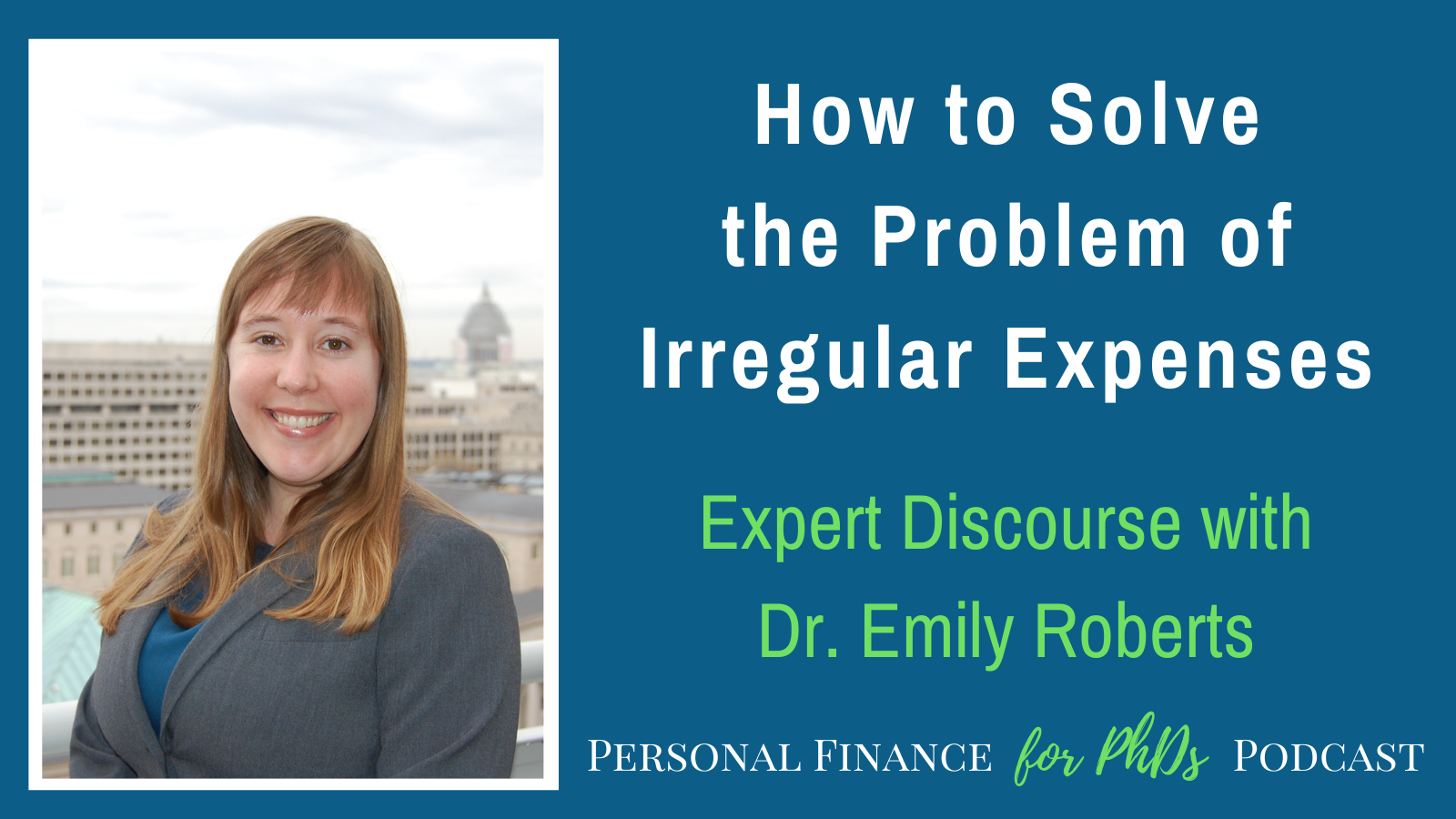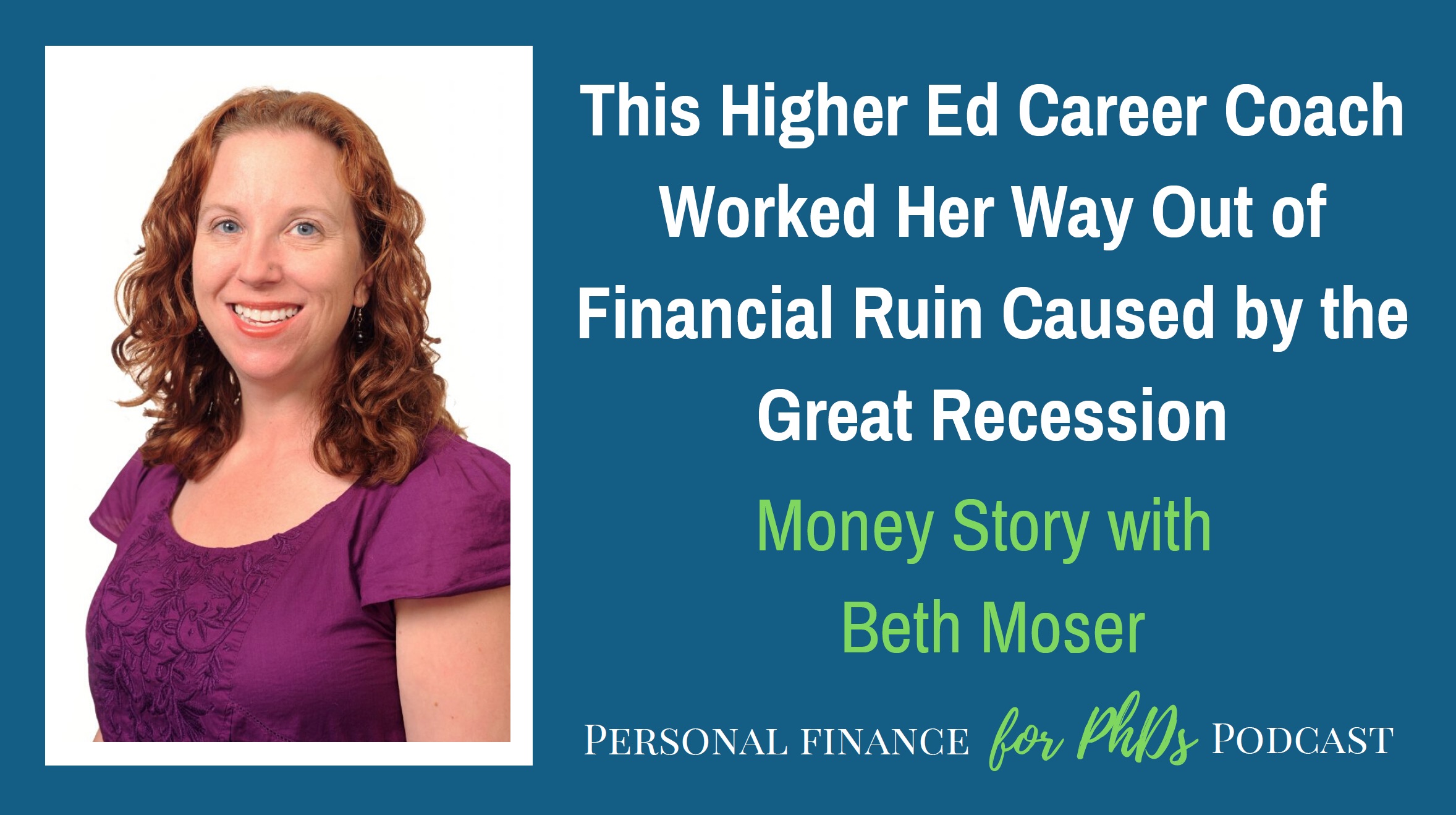In this episode, Emily tells the story of starting to use the strategy that completely revolutionized her budget when she was a grad student. She teaches this strategy in almost all of the seminars she gives for universities, and it never fails to generate a high level of interest and follow-up questions. The strategy is called targeted savings, and it is a solution to the problem of irregular expenses. Irregular expenses are any expenses that occur less frequently than monthly that are difficult to pay for in the moment, such as flights, car repairs, electronics, gifts, etc. Irregular expenses don’t pose a problem for every budget, but they commonly do for lower earners like grad students. Targeted savings is a particular method for predicting and saving up in advance for these irregular expenses. If you listen through this episode and are motivated to implement a system of targeted savings, you are invited to join the Personal Finance for PhDs Community to access a full course on targeted savings, including a custom spreadsheet, and the December 2020 Challenge to create or update their targeted savings for 2021.
Links Mentioned

Welcome to the Personal Finance for PhDs Podcast: A Higher Education in Personal Finance. I’m your host, Dr. Emily Roberts.
This is Season 7, Episode 15, and today I don’t have a guest but rather am going to tell you about the strategy that completely revolutionized my budget when I was a grad student. I teach this strategy in almost all of the seminars I give for universities, and it never fails to generate a high level of interest and follow-up questions.
The strategy is called targeted savings, and it is a solution to the problem of irregular expenses. Irregular expenses are any expenses that occur less frequently than monthly that are difficult to pay for in the moment, such as flights, car repairs, electronics, gifts, etc. Irregular expenses don’t pose a problem for every budget, but they commonly do for lower earners like grad students. Targeted savings is a particular method for predicting and saving up in advance for these irregular expenses.
If you listen through this episode and are motivated to implement a system of targeted savings, I invite you to join the Personal Finance for PhDs Community.
I recently added a full course on targeted savings, including a custom spreadsheet, and in December 2020 I’m running a Challenge for the Community for all participants to create or update their targeted savings for 2021. If you want to take the course and/or participate in the Challenge, join the Community at PFforPhDs.com/targeted/.
Without further ado, here’s my episode, on how to solve the problem of irregular expenses.
Definition of Irregular Expense
I’d like to first expand on the definition of irregular expenses and explain why they are such a problem for early-career PhDs in particular.
Irregular expenses are expenses that occur less frequently than monthly, so they don’t really have a spot in a traditional monthly budget the way rent, utilities, groceries, etc. do. Yet, these expenses are predictable, at least in a general sense. You probably have some irregular expenses that occur in a fixed amount at a reliable point in the year, such as an insurance premium or a fee for your university. Other irregular expenses might not have a precise amount or date assigned to them, but it’s fairly certain they’ll crop up sometime, such as purchasing clothes or shoes.
I believe that irregular expenses cause more trouble for early-career PhDs than for our peers who have Real Jobs in their 20s and 30s for two reasons.
First, graduate students and sometimes postdocs have relatively low incomes. For someone whose income far exceeds their fixed expenses, irregular expenses don’t pose much of an issue. They can pay for the expense in the month it arises by cutting back slightly in some variable spending areas of the budget or deferring some spending. Maybe they save a little less or aren’t able to pay off as much debt as usual. But what if the irregular expense rivals or exceeds the portion of your income that doesn’t have to go to fixed expenses? That is fairly common situation for graduate students.
Second, graduate students and sometimes postdocs have more irregular expenses because they are graduate students or postdocs. PhDs often move away from loved ones and therefore incur travel expenses to visit them. Universities often charge fees that have to be paid once per year or term instead of being prorated to be taken out of each paycheck. If income tax on fellowships is not withheld by the university, that creates another irregular expense for the fellow. Research and conference expenses, whether reimbursed or not, are another type of irregular expense. These are all in addition to the irregular expenses that anyone might have.
Common Solutions for Irregular Expenses
Now that we’ve established what irregular expenses are, let’s discuss the various ways people handle them.
I mentioned one solution already, which is simply to cut back in other spending areas or savings goals in the short term so that you can pay for the irregular expense fully in the month that it arises. This solution pairs really well with keeping what I call a unique monthly budget, which is to write a unique budget for every single month that accounts for one-off expenses. However, this is not a viable solution, like I just outlined, if your income does not far exceed your monthly necessary and/or fixed expenses.
Probably the most common solution is to put the expense on a credit card to buy some time. By floating the charge on a credit card until the due date, you can spread the expense out over about two months and therefore have a better chance of paying for it using the prior strategy. For a larger expense, you might even end up carrying a balance for several months to spread out the repayment even more. Using credit cards in this way is not ideal, because you are obligating your future income to past purchases that should be paid for with past income, plus if you do carry a balance you’ll be charged interest.
The final common solution for irregular expenses is to have some cash savings available that you can draw from when an irregular expense arises. Then, you can replace the savings over time. One of the subtle advantages to this solution is that you will almost certainly consider the irregular expense more carefully and look for alternatives if you are spending cash vs. using debt. You might end up choosing not to incur the irregular expense at that time or shopping around for a better value. Plus, of course, there are no interest charges, and you can handle larger expenses than if you were only using the first strategy.
Targeted savings, the strategy I’m teaching you in this episode, is a more detailed version of this third strategy that involves advance planning as well as advance saving.
How I Started Using Targeted Savings
I first noticed my need for an intentional solution to this problem of irregular expenses about two years into my PhD.
Prior to that point, I had used all three of the solutions I just mentioned to handle irregular expenses.
When I was living paycheck to paycheck with no cash savings and an irregular expense came up, I would cut back as much as I could in my discretionary variable spending in that month to pay for it.
On an occasion or two, I still wasn’t able to swing the expense, so I put the expense on a credit card to float it into the next month, meaning the frantic cutting back on expenses lasted even longer. This was super difficult and unpleasant because on a stipend there’s not exactly a lot of fat in the first place.
Later, I did have a small general savings account, which I could dip into and then refill to pay for the irregular expense.
What happened after my second year of grad school is that I got married to another grad student, Kyle. We burned through almost all of our cash savings paying for our rings, honeymoon, and our portion of the wedding expenses. When we got back from our honeymoon and started combining our finances and setting up a joint budget, we realized that we only had $1,200 remaining in cash savings, which I felt obligated to call our emergency fund. So paying for irregular expenses out of existing savings was no longer an option.
It turned out that the summer we got married was a wedding boom among our friends. In fact, and I’m sure this will sound familiar to many of you, that summer kicked off a period of several years in our mid-twenties in which we were invited to about half a dozen weddings each year, most of them requiring us to travel.
Now, I love attending weddings. I very much wanted to share the joy of every couple who invited us to their wedding as we had so recently shared our joy. But we had no savings to help make that happen, and I had become savvy enough about personal finance to know I shouldn’t use a credit card if I couldn’t pay off the charge right away.
In that particular summer, we ended up declining a couple of the wedding invitations and cash flowing the irregular expenses associated with the weddings we did attend. We took a hard look at our new joint budget and found ways to reduce our spending on a monthly basis so we could handle the irregular expenses that we did incur.
As we financially caught our breath at the end of that summer, I resolved that I did not want to go through that again. I assumed—correctly—that we would have another big wedding season the next summer, and I didn’t want to have to scramble to pay for the travel and gifts and attire and everything, and I didn’t want to have to turn down invitations for financial reasons.
I had heard of this strategy known as targeted savings or sinking funds, so Kyle and I agreed to start saving up right then for the wedding guest-related expenses we assumed would come our way in fewer than 12 months. We didn’t know all the details at that moment of what the expenses would be and when they would occur, but it was a reasonable assumption that they would occur. We opened a new savings account, called it “Travel and Wedding Gifts,” and set up an autodraft to contribute money to it every month. The frugal measures we had put in place over the past few months helped us to establish that savings rate. The next year, when we did incur those expenses, we drew from that account to pay for them, and we didn’t have any of the stress and scramble associated with that spending that we did the year before.
General Solution
This is the basic concept of targeted savings. You anticipate an irregular expense, and you do your best to predict the amount and timing of that expense. Then, you establish a savings rate into a dedicated account that will sum to that amount by that time. It’s a really simple idea, though it can be tricky to implement, especially when you endeavor to capture and prepare for all of your irregular expenses, as I soon did.
Expanding the Solution
We didn’t stop with just wedding guest-related expenses. Over the course of the next few months, other types of irregular expenses arose. In September, Kyle and I paid up front for our two yearly university parking permits. In October, we purchased a season ticket to the Duke men’s basketball home games—Go Devils!—and two season tickets to the Broadway musicals series at our local theater. In November, we purchased cross-country flights to see our family over winter break.
We decided to apply our new system to these other expense categories, plus even more. Each time we cash flowed one of these irregular expenses by cutting back our other spending, we set up a new savings account and autodraft to fund that purchase for the following year.
It was not trivial to both pay for these irregular expenses out of cash flow and start saving up for the next year, but we managed it through putting in place frugal strategies that we hadn’t tried before. We canceled cable TV, stopped eating out for convenience, switched where we shopped for groceries, line dried our clothes, pursued credit card rewards, and more.
By the time a full year had passed, we had encountered or thought of every irregular expense in our lives at that time. We had set up separate savings accounts with our bank, and each one had a monthly autodraft to fund it.
Here are the names of our six targeted savings accounts and their savings rates from that time:
- Appearance $35/mo
- Cars $185/mo
- Community Supported Agriculture $35/mo
- Entertainment $60/mo
- Medical/Dental/Vision $70/mo
- Travel and Gifts $390/mo
Key Insight
This system worked very, very well for us, and it works well for many people I’ve spoken with about it. Targeted savings turns large, irregular expenses into small, fixed expenses that are easier to write into a budget. An effective monthly budget is a cornerstone personal finance strategy and is instrumental in helping you reach just about any financial goal, but a budget cannot be effective if it is continually derailed by irregular expenses.
Predicting and preparing for irregular expenses, whether through savings or a cash flow plan, is so important that I made it its own step in the Financial Framework I developed for PhDs, right after paying off high-priority debt and before investing for retirement.
The value of the strategy is not only in predicting and preparing for irregular expenses, although that alone would be reason enough to use it. What I’ve learned from using this strategy is that it helps you compare regular and irregular expenses head-to-head, which is really difficult to do otherwise.
In the absence of a system for predicting and preparing for irregular expenses, you’re flying by the seat of your pants with every irregular expense or spending opportunity that arises. You have to make a quick decision about whether or not you will spend and how your budget will accommodate that spending. In that moment, there is nearly always intense pressure to spend, either internal or external.
Implementing targeted savings has you take a bird’s-eye view of your spending over the course of a year, both regular and irregular. By considering spending decisions well before they actually arise, you take a lot of the pressure off the decision. By converting one-time expenses to expenses that you save for every month, you can more easily answer the question, “Would I rather spend $120 on this irregular expense or $10 per month on this regular expense?”
The trade-off was always there, but targeted savings makes it easier to make an optimal decision. Sometimes, you really rather would spend the $10 per month on a regular expense, so you can make a clear-headed decision to decline the $120 irregular expense. Targeted savings help you organize your spending so that it brings you the maximum possible satisfaction over the course of a year.
Our Targeted Savings Accounts Today
Kyle and I used targeted savings throughout the rest of grad school, and it helped us to spend on travel, car repairs, a DSLR camera, Christmas gifts for Kyle’s huge extended family, fellowship tax bills, dental checkups, business formal clothes, spontaneous charitable gifts, and much more—without anywhere near as much financial stress as we had experienced before using the system.
In fact, we kept using targeted savings even after we finished grad school and our household income increased. Even though we could cash flow pretty much any irregular expense now, I prefer to try to predict them and weigh how much we should spend in one budget category vs. another. In fact, we stopped using the system for the first year after we moved from Durham to Seattle because that was a major upheaval, but we started up again after that year because it was psychologically much preferable.
Targeted savings is not static, and you should iterate it every year at least to keep up with your shifting priorities and spending opportunities. Wedding guest-related expenses are no longer a big driver in our targeted savings system, and spending on our children now holds a place.
Our targeted savings categories as of early 2020 were:
- Appearance
- Cars
- Childcare
- Electronics
- Entertainment
- Gifts
- Housewares
- Life Insurance Premiums
- Medical/Dental/Vision Copays and Coinsurance
- Miscellaneous Kid Expenses
- Travel
Course on Targeted Savings
I’ve thoroughly explored targeted savings through reflecting on my practice, talking with other PhDs about theirs, and reading how other personal finance experts use it. I’ve distilled the insights I’ve gained into my new course, Targeted Savings: The Solution for Irregular Expenses.
The course delves deeply into how to design and implement a system of targeted savings so that it captures all your problematic irregular expenses.
The course answers or helps you find your own answers to:
- What kind of account or accounts should I keep my targeted savings in?
- Do I need to switch banks to facilitate this practice?
- How do I predict my expenses for the upcoming year?
- Should I prepare for my irregular expenses individually or as groups?
- Should I dedicate existing general savings to targeted savings and if so how?
- How do I calculate the savings rates?
- What do I do if an expense pops up that I didn’t predict?
- Should my emergency fund be separate from my targeted savings?
- How do I tell if an expense should be covered by my emergency fund or targeted savings?
and, the one that I have to answer for myself every single time I update my system:
- What should I do if my calculated targeted savings rates are too high to fit into my monthly budget?
If you’re excited by the idea of targeted savings but not sure how to really get it going, please consider joining the Personal Finance for PhDs Community to access the course and December 2020’s Community Challenge. The Challenge is to create or update your system of targeted savings to be ready to go in January 2021. I know I personally need this update as our 2020 spending did not go at all as we had expected. As you go through the course and work on your system, you can report your progress and/or ask for help from me and the other Community members in the forum threads dedicated to the Challenge. The Challenge exists to keep you accountable to your goal of creating targeted savings and to assist you in overcoming any speed bumps you encounter. Even if you’re listening to this later on, as a Community member you’re always welcome to participate in past Challenges, and I’ll still provide support.
You can learn more about Targeted Savings: The Solution for Irregular Expenses and join the Personal Finance for PhDs Community at PFforPhDs.com/targeted/. I actually have made available on that page the first module of the course to give you a flavor of the content, and that module includes a list of two dozen common categories of irregular expenses for early-career PhDs.
Thank you so much for joining me for this episode! I highly recommend you test out the strategy of targeted savings in your own budget. It is a game-changer.



